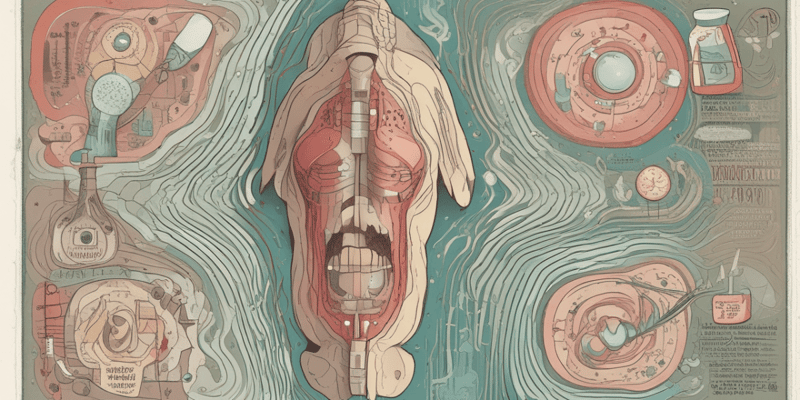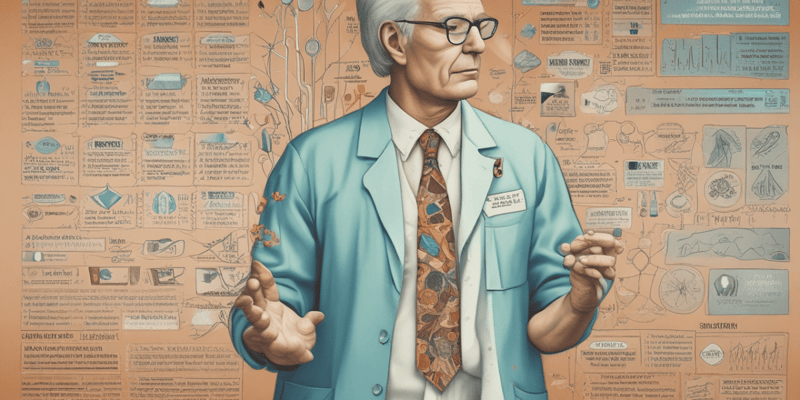Podcast
Questions and Answers
What is a key factor in determining an effective pain management approach?
What is a key factor in determining an effective pain management approach?
What role do adjuvant analgesic drugs play in pain management?
What role do adjuvant analgesic drugs play in pain management?
Which of the following is NOT considered a characteristic to assess in pain management?
Which of the following is NOT considered a characteristic to assess in pain management?
What does the Gate Theory of Pain primarily explain?
What does the Gate Theory of Pain primarily explain?
Signup and view all the answers
Which of these drugs is classified as an adjuvant analgesic for neuropathic pain?
Which of these drugs is classified as an adjuvant analgesic for neuropathic pain?
Signup and view all the answers
What is one of the indications for the use of opioids?
What is one of the indications for the use of opioids?
Signup and view all the answers
Which condition is considered a contraindication for the use of opioids?
Which condition is considered a contraindication for the use of opioids?
Signup and view all the answers
What is a common adverse effect associated with analgesics?
What is a common adverse effect associated with analgesics?
Signup and view all the answers
In cases of severe respiratory depression caused by opioids, which medication should be administered?
In cases of severe respiratory depression caused by opioids, which medication should be administered?
Signup and view all the answers
Which of the following conditions requires extreme caution when using analgesics?
Which of the following conditions requires extreme caution when using analgesics?
Signup and view all the answers
What is the primary function of opioid agonists?
What is the primary function of opioid agonists?
Signup and view all the answers
Which of the following drugs is classified as a strong agonist?
Which of the following drugs is classified as a strong agonist?
Signup and view all the answers
What effect does opioid ceiling effect have on pain relief?
What effect does opioid ceiling effect have on pain relief?
Signup and view all the answers
Which classification of opioids causes a weaker response than a full agonist?
Which classification of opioids causes a weaker response than a full agonist?
Signup and view all the answers
What is the role of Narcan in opioid treatment?
What is the role of Narcan in opioid treatment?
Signup and view all the answers
How is equianalgesia defined?
How is equianalgesia defined?
Signup and view all the answers
Which opioid drug is noted to be seven times more potent than morphine?
Which opioid drug is noted to be seven times more potent than morphine?
Signup and view all the answers
What characterizes an opioid antagonist?
What characterizes an opioid antagonist?
Signup and view all the answers
What is NOT a symptom of opioid withdrawal?
What is NOT a symptom of opioid withdrawal?
Signup and view all the answers
Which substance should be considered potentially interacting with analgesics?
Which substance should be considered potentially interacting with analgesics?
Signup and view all the answers
What should be performed before beginning therapy with analgesics?
What should be performed before beginning therapy with analgesics?
Signup and view all the answers
What is the purpose of the OLDCART acronym in pain assessment?
What is the purpose of the OLDCART acronym in pain assessment?
Signup and view all the answers
What should patients be cautious about concerning OTC medications when on analgesics?
What should patients be cautious about concerning OTC medications when on analgesics?
Signup and view all the answers
What is one potential side effect of using herbal products related to the marigold family?
What is one potential side effect of using herbal products related to the marigold family?
Signup and view all the answers
What approach is encouraged for managing pain according to nursing implications?
What approach is encouraged for managing pain according to nursing implications?
Signup and view all the answers
What action should be taken if patients exhibit signs of a reaction to analgesics?
What action should be taken if patients exhibit signs of a reaction to analgesics?
Signup and view all the answers
Study Notes
Pain
- Pain is an unpleasant sensory and emotional experience associated with actual or potential tissue damage
- Pain is a personal experience
- Pain exists when the patient says it exists
- Pain involves physical, psychological, and cultural factors
Pain Management
- Pain management is an important aspect of nursing care.
- Pain is one of the most common reasons people seek healthcare.
- Pain can lead to suffering and economic burden.
- There is no single approach to effective pain management.
- Pain management is tailored to each patient's needs.
- Consider the cause of pain, concurrent medical conditions, pain characteristics (psychological and cultural), and ongoing assessments.
Analgesics
- Analgesics are “painkillers.”
- Analgesic drugs include opioid analgesics and adjuvant analgesic drugs.
- Adjuvant analgesic drugs assist primary drugs in relieving pain.
- Examples of adjuvant analgesics include NSAIDs, antidepressants, anticonvulsants, and corticosteroids.
- Adjuvant drugs for neuropathic pain include amitriptyline (antidepressant) and gabapentin (anticonvulsants).
- NSAIDs and corticosteroids reduce inflammation.
Gate Theory of Pain Transmission
- The gate theory of pain transmission is a common theory used to explain how impulses from damaged tissues are sensed in the brain.
- Many current pain management strategies aim to alter this system.
Treatment of Pain in Special Situations
- Pain management can involve balancing patient comfort with fear of drug addiction.
- Treatment should address opioid tolerance.
- Treatment may include the use of placebos.
- Healthcare professionals should recognize patients who are opioid tolerant.
Patient-Controlled Analgesia (PCA)
- PCA allows patients to self-administer pain medication.
- PCA by Proxy allows another person to control the pain pump.
Opioid Drugs
- Opioid drugs are synthetic drugs that bind to opiate receptors to relieve pain.
- Mild agonists include codeine and hydrocodone.
- Strong agonists include morphine, hydromorphone, oxycodone, meperidine, fentanyl, and methadone.
Opioid Ceiling Effect
- Opioid ceiling effect occurs when a drug reaches a maximum analgesic effect.
- Analgesia does not improve even with higher doses of the drug.
- Pentazocine and nalbuphine are examples of drugs that exhibit a ceiling effect.
Mechanisms of Analgesic Action
- Analgesics are classified into three groups based on their actions: agonists, agonists-antagonists, and antagonists.
Agonists
- Agonists bind to an opioid pain receptor in the brain.
- Agonists cause an analgesic response (reduction of pain sensation).
Agonists-Antagonists
- Agonists-antagonists bind to a pain receptor.
- Agonists-antagonists cause a weaker neurological response compared to a full agonist.
- Agonists-antagonists are also called partial agonists or mixed agonists.
Antagonists
- Reverse the effects of these drugs on pain receptors.
- Bind to pain receptors and exert no response.
- Also known as competitive antagonists.
- Example: Narcan.
Equianalgesia
- Equianalgesia is the ability to provide pain relief by calculating dosages of different drugs or routes of administration that provide comparable analgesia.
- Example: Hydromorphone (Dilaudid) is seven times more potent than morphine.
- Example: If a patient is given morphine 10mg, and 1 hour later hydromorphone 1mg, the patient would have received an equivalent of 17mg of morphine.
Analgesic Indications
- Used to alleviate moderate to severe pain.
- Often given with adjuvant analgesic drugs to assist primary drugs with pain relief.
- Other uses: cough center suppression, treatment of diarrhea, and balanced anesthesia.
Analgesics: Contraindications
- Known drug allergy.
- Severe asthma.
- Use with extreme caution in those with respiratory insufficiency, elevated intracranial pressure, morbid obesity or sleep apnea, paralytic ileus, and pregnancy.
Analgesics: Adverse Effects
- CNS depression (which leads to respiratory depression).
- Nausea and vomiting.
- Urinary retention.
- Diaphoresis and flushing.
- Pupil constriction
- Constipation.
- Itching.
Analgesics: Toxicity and Management of Overdose
- Toxicity is managed with Naloxone (Narcan) or Naltrexone (ReVia).
- Even if a patient is experiencing withdrawal symptoms, an opioid antagonist should be administered if they have severe respiratory depression.
- Opioid withdrawal or opioid abstinence syndrome is characterized by anxiety, irritability, chills and hot flashes, joint pain, lacrimation, rhinorrhea, diaphoresis, nausea, vomiting, abdominal cramps, diarrhea, and confusion.
Analgesics: Interactions
- Alcohol, antihistamines, barbiturates, benzodiazepines, and monoamine oxidase inhibitors can interact with analgesics.
Herbal Products: Feverfew
- Feverfew is related to the marigold family.
- Feverfew has anti-inflammatory properties and is used to treat migraine headaches, menstrual cramps, inflammation, and fever.
- Feverfew may cause GI distress, altered taste, and muscle stiffness.
- Feverfew may interact with aspirin, other NSAIDs, and anticoagulants.
Analgesics: Nursing Process
- Before beginning therapy, perform a thorough history regarding allergies and the use of other medications, including alcohol, health history, and medical history.
- Obtain baseline vitals.
- Assess for potential contraindications and drug interactions.
- Perform a thorough pain assessment using the OLDCART acronym:
- O-Onset
- L-Location
- D-Duration
- C-Characteristics
- A-Aggravating factors
- R-Relieving factors
- T-treatments tried
- Medicate patients before pain becomes severe to provide adequate analgesia and pain control.
- Pain management includes pharmacologic and nonpharmacologic approaches; include other interventions as indicated.
- Patients should not take other medications or OTC preparations without checking with their physicians.
- Alert the physician to any signs of a reaction or adverse effect.
Studying That Suits You
Use AI to generate personalized quizzes and flashcards to suit your learning preferences.
Related Documents
Description
This quiz explores the critical aspects of pain management in nursing care, including the nature of pain, its personal experience, and factors affecting it. It also discusses various analgesics and their roles in effective pain relief tailored to patient needs. Test your knowledge on pain management strategies and analgesic classifications.




